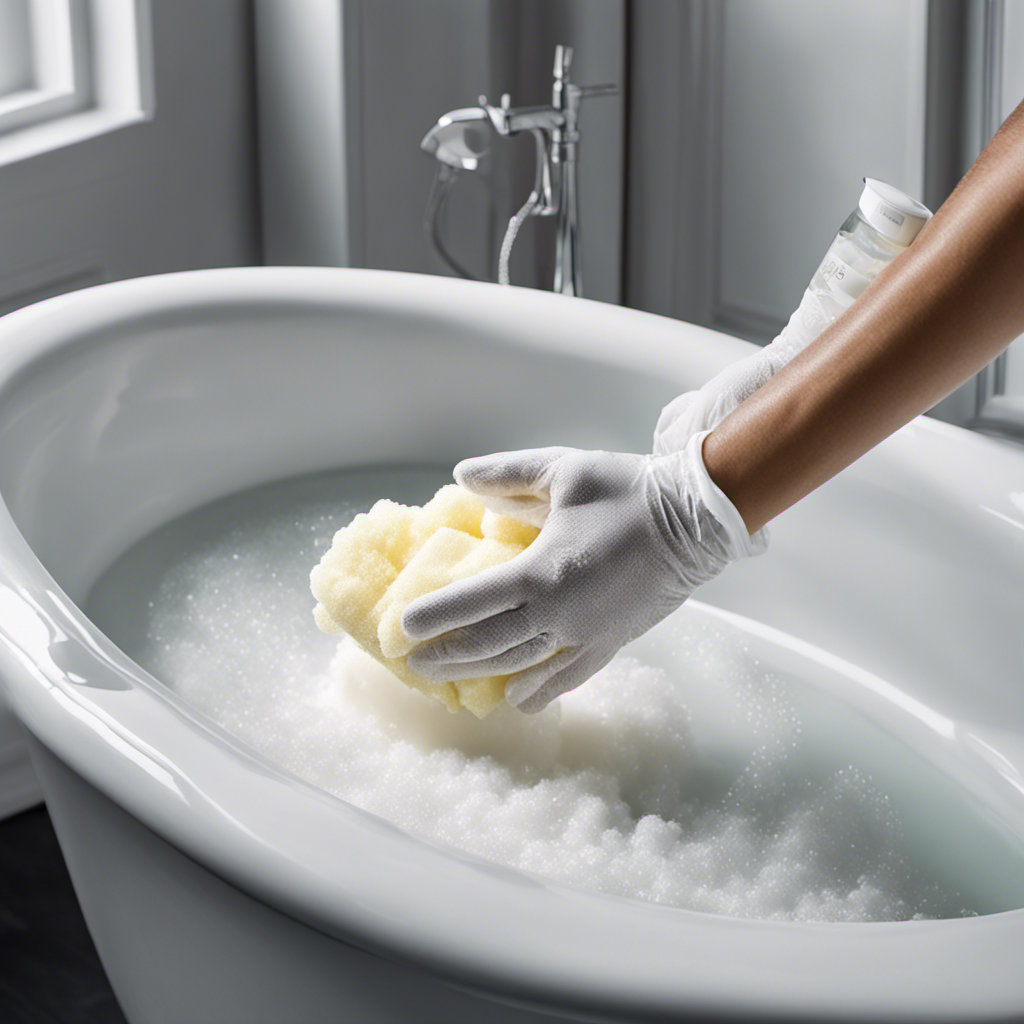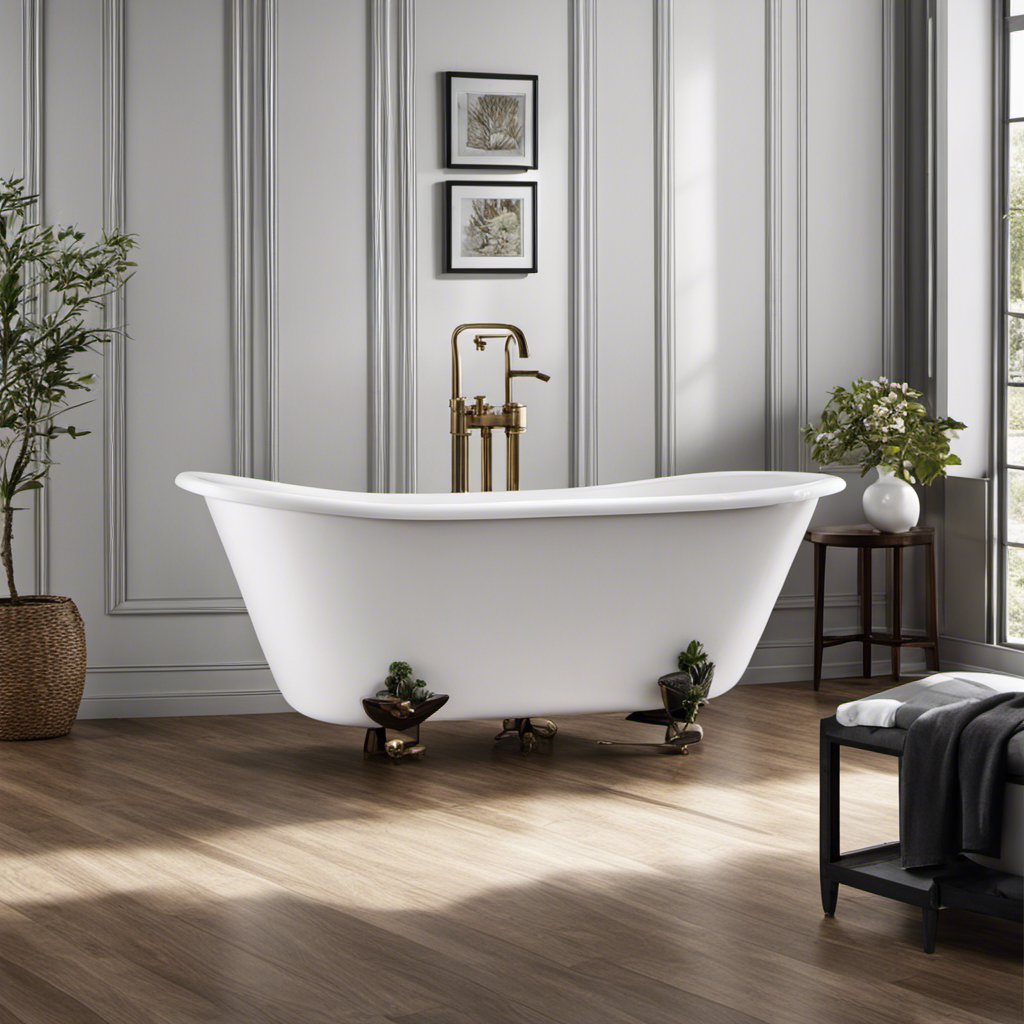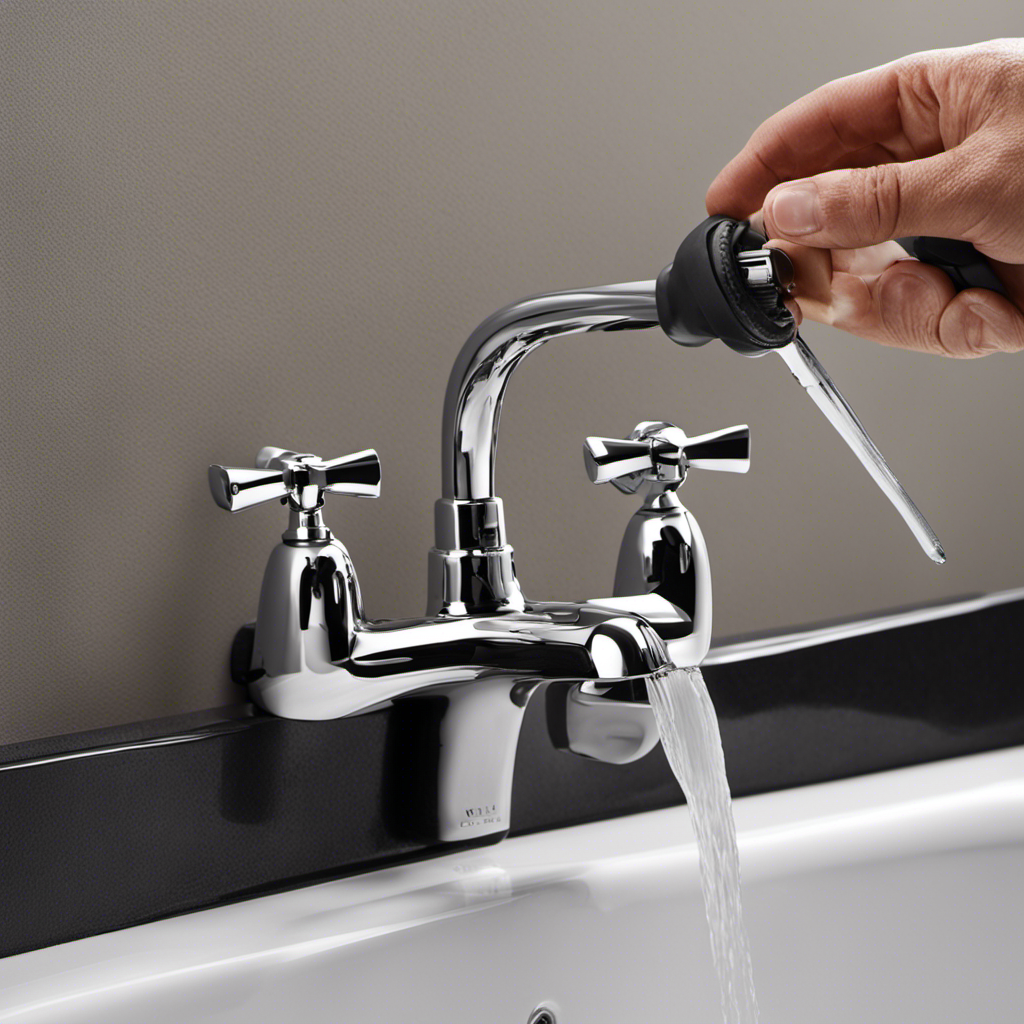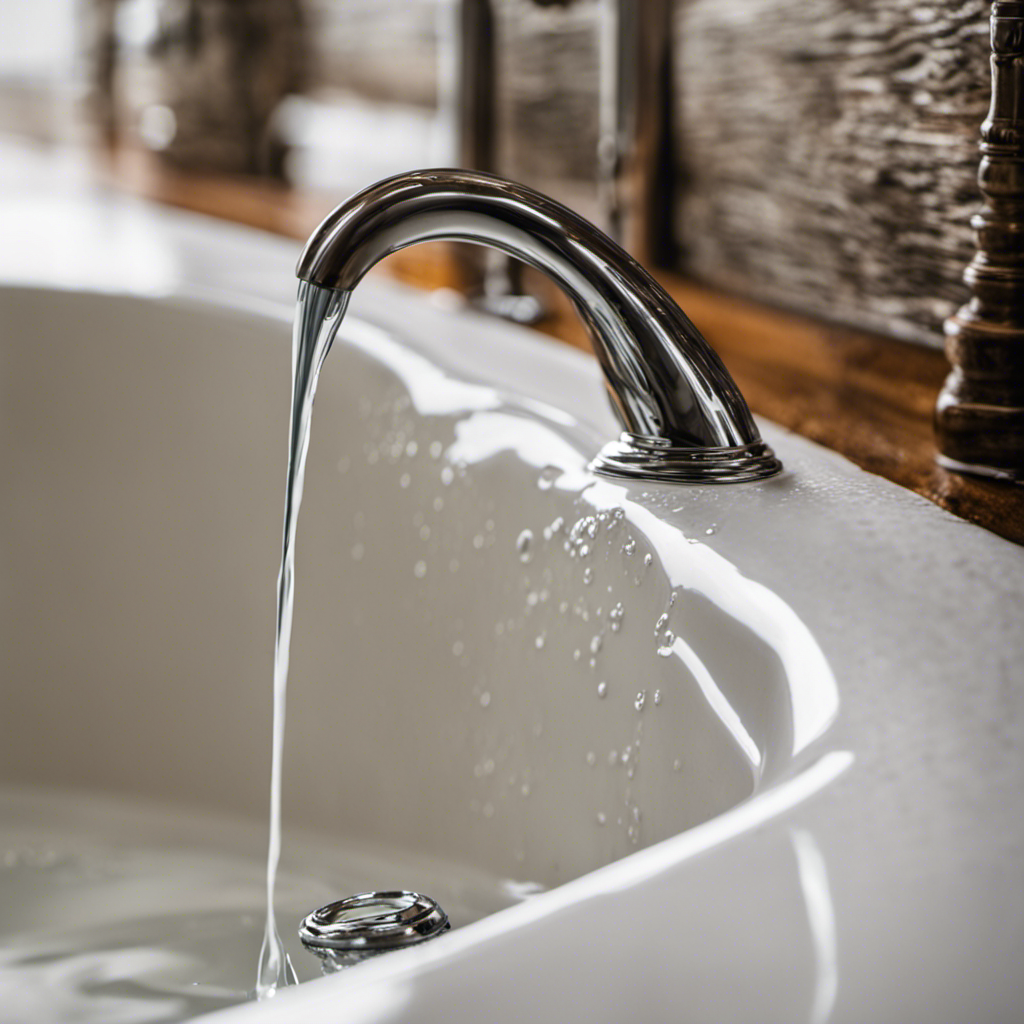Hey there! So you’ve got yourself a whirlpool bathtub, huh? It’s a blissful oasis of relaxation and rejuvenation. But, let’s face it, it can get pretty grimy over time.
No worries though, because I’m here to guide you through the step-by-step process of cleaning it. From understanding the inner workings of your whirlpool bathtub to gathering the necessary supplies, I’ve got you covered.
So sit back, relax, and let’s dive into the world of whirlpool bathtub cleaning.
Key Takeaways
- Whirlpool bathtubs provide a relaxing and therapeutic bathing experience by releasing pressurized water and air to create a swirling motion.
- Cleaning supplies for a whirlpool bathtub include non-abrasive bathtub cleaner, mild dish soap, white vinegar, soft-bristle brush, sponge or cloth, and a toothbrush for hard-to-reach areas.
- The step-by-step cleaning process includes filling the tub with warm water and cleaning solution, running the jets for 15 minutes, draining the tub and scrubbing surfaces, using white vinegar for stubborn stains, and thoroughly rinsing the tub.
- To maintain and prevent build-up in the whirlpool bathtub, regularly use a jet cleaner, flush out residue after each use, and periodically scrub surfaces with a soft brush and mild cleaning solution.
Understanding the Whirlpool Bathtub
Understanding the whirlpool bathtub can be helpful when it comes to cleaning it effectively.
A whirlpool bathtub is designed to provide a relaxing and therapeutic bathing experience. It utilizes jets that release pressurized water and air to create a swirling motion in the tub. This functionality not only helps in soothing sore muscles and joints but also promotes better blood circulation.
The benefits of a whirlpool bathtub go beyond relaxation. It can aid in relieving stress and anxiety, improving sleep quality, and enhancing overall well-being.
To ensure that you can enjoy these benefits for a long time, proper cleaning is essential. Now that we understand the functionality and benefits of a whirlpool bathtub, let’s move on to gathering the necessary cleaning supplies.
Gathering the Necessary Cleaning Supplies
First, you’ll need to gather all the necessary supplies for cleaning it. Cleaning a whirlpool bathtub requires specific tools and products to ensure a thorough and effective cleaning process. Here are the essential supplies you’ll need:
-
Cleaning agents:
-
Non-abrasive bathtub cleaner
-
Mild dish soap
-
White vinegar
-
Tools:
-
Soft-bristle brush
-
Sponge or cloth
-
Toothbrush (for hard-to-reach areas)
-
Accessories:
-
Rubber gloves
-
Old toothbrush (for scrubbing)
Now that you have gathered all the supplies, you can proceed with the cleaning techniques. Start by filling the tub with warm water and adding the recommended amount of bathtub cleaner or mild dish soap. Run the jets for about 15 minutes to allow the cleaning solution to circulate.
Afterward, drain the tub and scrub the surfaces using a soft-bristle brush or sponge. For stubborn stains, you can use a mixture of white vinegar and water. Remember to rinse the tub thoroughly to remove any residue.
With these cleaning techniques, you’ll be able to remove stubborn stains and keep your whirlpool bathtub sparkling clean.
Step-by-Step Cleaning Process for the Whirlpool Bathtub
Now that you have all the necessary supplies, you can begin the step-by-step cleaning process for your whirlpool bathtub.
To start, fill the tub with warm water until it covers the jets. Add a quarter cup of dish soap or a whirlpool-specific cleaner.
Turn on the jets and let them run for 15 minutes to remove any dirt or residue.
Afterward, drain the water and refill the tub with clean water. Run the jets again for another 15 minutes to rinse out any remaining soap.
Finally, drain the water and wipe down the tub with a soft cloth.
Troubleshooting common issues during the cleaning process include checking for clogged jets and ensuring that the water circulation is functioning properly.
Now that you know how to clean your whirlpool bathtub, let’s move on to maintaining and preventing build-up.
Maintaining and Preventing Build-up in the Whirlpool Bathtub
To maintain a clean and efficient whirlpool bathtub, it’s important to regularly use a jet cleaner and flush out any residue. This will help prevent mold growth and remove hard water stains.
Here are some tips to keep your whirlpool bathtub in top shape:
-
Use a jet cleaner: Regularly use a jet cleaner specifically designed for whirlpool bathtubs to eliminate any buildup and prevent mold growth.
-
Flush out residue: After each use, fill the tub with hot water and run the jets for a few minutes to flush out any leftover soap, oil, or debris.
-
Scrub with a soft brush: Periodically scrub the surfaces of the whirlpool bathtub using a soft brush and a mild cleaning solution to remove any hard water stains or grime.
Additional Tips and Tricks for a Sparkling Clean Whirlpool Bathtub
Regularly using a jet cleaner and flushing out residue after each use will help maintain a sparkling whirlpool bathtub.
However, there are additional tips and tricks that can ensure your whirlpool bathtub stays pristine.
When it comes to cleaning solution alternatives, one option is to use a mixture of baking soda and vinegar. This natural solution effectively removes grime and odors without the use of harsh chemicals.
Another alternative is to use a commercial whirlpool cleaner specifically designed for jetted tubs. These cleaners typically contain enzymes that break down and remove buildup.
If you encounter any common issues with your whirlpool bathtub, such as weak jets or strange noises, it’s important to troubleshoot them promptly. This may involve checking the air intake valves, cleaning the jet nozzles, or contacting a professional for assistance.
Frequently Asked Questions
How Often Should I Clean My Whirlpool Bathtub?
I clean my whirlpool bathtub every two weeks to keep it in top condition. I find that using the best cleaning products for whirlpool bathtubs ensures a thorough and effective clean.
Can I Use Regular Household Cleaning Products to Clean My Whirlpool Bathtub?
I learned the hard way that using regular household cleaning products on my whirlpool bathtub wasn’t the best idea. They didn’t effectively remove the grime and left a residue. Specialized cleaners are a much better alternative.
Is It Safe to Use Bleach or Other Harsh Chemicals to Clean the Whirlpool Bathtub?
It’s not safe to use bleach or other harsh chemicals on a whirlpool bathtub. Instead, try using bleach alternatives or natural cleaning methods. These will effectively clean your tub without causing damage or potential health risks.
Can I Use a Scrub Brush or Abrasive Sponge to Clean the Whirlpool Bathtub?
Using a scrub brush or abrasive sponge to clean a whirlpool bathtub may scratch the surface and damage the jets. It is best to use non-abrasive cleaning tools and products made for whirlpool tubs.
How Long Should I Let the Cleaning Solution Sit in the Whirlpool Bathtub Before Rinsing?
I let the cleaning solution sit in the whirlpool bathtub for about 15 minutes before rinsing. It’s important to properly maintain a whirlpool bathtub to ensure its benefits, such as relaxation and improved circulation.
Conclusion
So there you have it, folks! Cleaning a whirlpool bathtub may seem like a daunting task, but with the right knowledge and supplies, it can be a breeze.
Remember to gather all your cleaning supplies, follow the step-by-step process diligently, and don’t forget to maintain your tub regularly to prevent any nasty build-up.
And hey, if you want your whirlpool bathtub to shine like a diamond, just follow these additional tips and tricks.
Happy cleaning, my fellow tub enthusiasts! May your whirlpool always be sparkling and your bath time always be relaxing.










